Emergency Department: Antibiotic Treatment for Sepsis in Children
VerifiedAdded on 2022/10/11
|8
|2138
|16
Homework Assignment
AI Summary
This assignment, prepared by a student nurse, focuses on the optimal antibiotic treatment for a three-year-old child presenting with potential sepsis in an emergency department. The student utilizes the PICO framework to formulate a clinical question comparing intravenous and oral antibiotic administration. A comprehensive search strategy is outlined, including keyword identification, alternative terms, database selection (MEDLINE, CINAHL, JBI, Cochrane), and search filters (time range, key terms, Boolean logic). The assignment includes five justifications for selected research articles, each assessed using the ARCOC framework (Authors, Relevance, Coverage, Objectivity, Currency). The student then reflects on the evidence, concluding that intravenous antibiotic administration is the preferred treatment for acute sepsis in children, especially those unable to eat or drink, based on the reviewed studies. The assignment underscores the importance of evidence-based practice in pediatric emergency care.
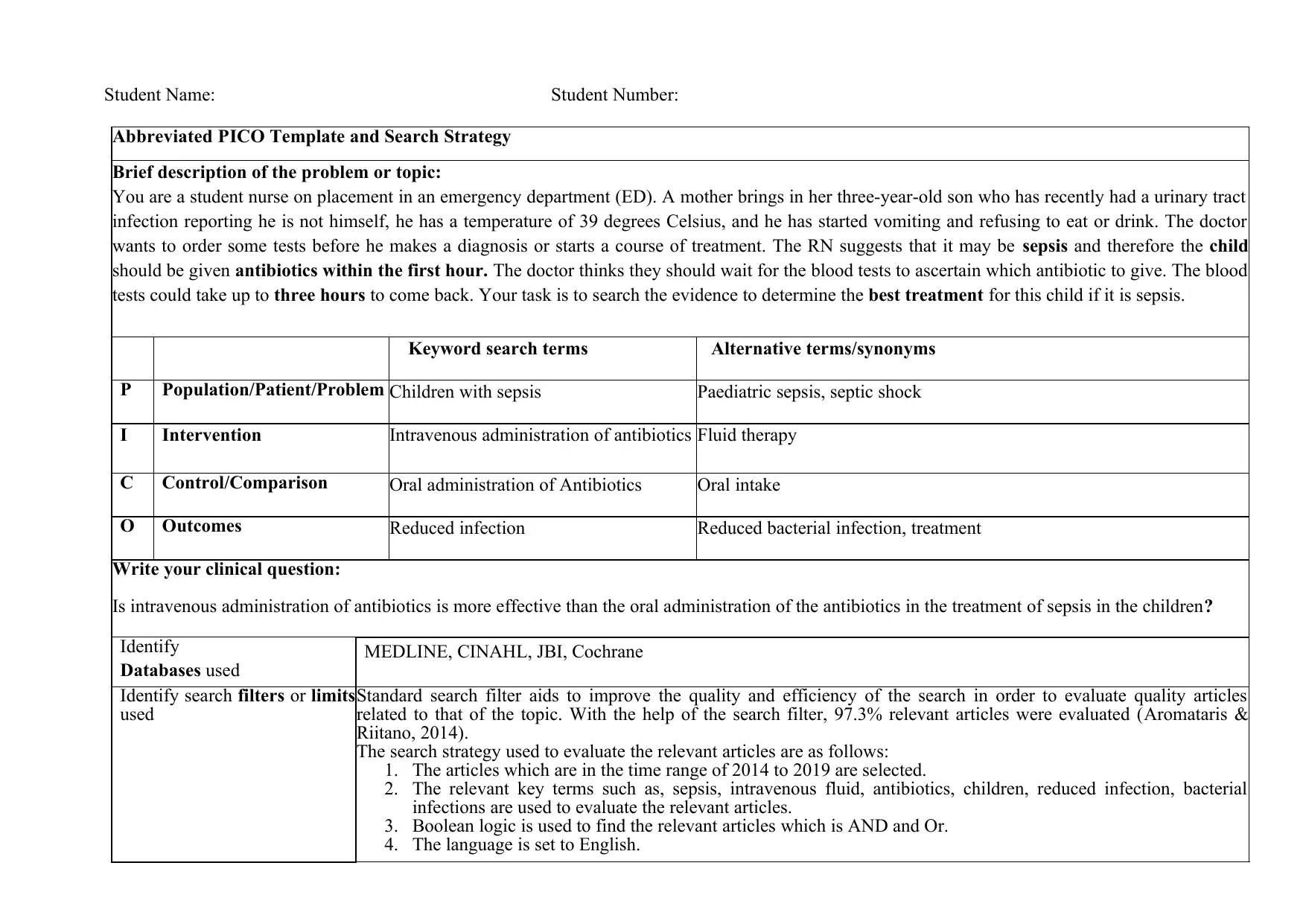
Student Name: Student Number:
Abbreviated PICO Template and Search Strategy
Brief description of the problem or topic:
You are a student nurse on placement in an emergency department (ED). A mother brings in her three-year-old son who has recently had a urinary tract
infection reporting he is not himself, he has a temperature of 39 degrees Celsius, and he has started vomiting and refusing to eat or drink. The doctor
wants to order some tests before he makes a diagnosis or starts a course of treatment. The RN suggests that it may be sepsis and therefore the child
should be given antibiotics within the first hour. The doctor thinks they should wait for the blood tests to ascertain which antibiotic to give. The blood
tests could take up to three hours to come back. Your task is to search the evidence to determine the best treatment for this child if it is sepsis.
Keyword search terms Alternative terms/synonyms
P Population/Patient/Problem Children with sepsis Paediatric sepsis, septic shock
I Intervention Intravenous administration of antibiotics Fluid therapy
C Control/Comparison Oral administration of Antibiotics Oral intake
O Outcomes Reduced infection Reduced bacterial infection, treatment
Write your clinical question:
Is intravenous administration of antibiotics is more effective than the oral administration of the antibiotics in the treatment of sepsis in the children?
Identify
Databases used MEDLINE, CINAHL, JBI, Cochrane
Identify search filters or limits
used Standard search filter aids to improve the quality and efficiency of the search in order to evaluate quality articles
related to that of the topic. With the help of the search filter, 97.3% relevant articles were evaluated (Aromataris &
Riitano, 2014).
The search strategy used to evaluate the relevant articles are as follows:
1. The articles which are in the time range of 2014 to 2019 are selected.
2. The relevant key terms such as, sepsis, intravenous fluid, antibiotics, children, reduced infection, bacterial
infections are used to evaluate the relevant articles.
3. Boolean logic is used to find the relevant articles which is AND and Or.
4. The language is set to English.
Abbreviated PICO Template and Search Strategy
Brief description of the problem or topic:
You are a student nurse on placement in an emergency department (ED). A mother brings in her three-year-old son who has recently had a urinary tract
infection reporting he is not himself, he has a temperature of 39 degrees Celsius, and he has started vomiting and refusing to eat or drink. The doctor
wants to order some tests before he makes a diagnosis or starts a course of treatment. The RN suggests that it may be sepsis and therefore the child
should be given antibiotics within the first hour. The doctor thinks they should wait for the blood tests to ascertain which antibiotic to give. The blood
tests could take up to three hours to come back. Your task is to search the evidence to determine the best treatment for this child if it is sepsis.
Keyword search terms Alternative terms/synonyms
P Population/Patient/Problem Children with sepsis Paediatric sepsis, septic shock
I Intervention Intravenous administration of antibiotics Fluid therapy
C Control/Comparison Oral administration of Antibiotics Oral intake
O Outcomes Reduced infection Reduced bacterial infection, treatment
Write your clinical question:
Is intravenous administration of antibiotics is more effective than the oral administration of the antibiotics in the treatment of sepsis in the children?
Identify
Databases used MEDLINE, CINAHL, JBI, Cochrane
Identify search filters or limits
used Standard search filter aids to improve the quality and efficiency of the search in order to evaluate quality articles
related to that of the topic. With the help of the search filter, 97.3% relevant articles were evaluated (Aromataris &
Riitano, 2014).
The search strategy used to evaluate the relevant articles are as follows:
1. The articles which are in the time range of 2014 to 2019 are selected.
2. The relevant key terms such as, sepsis, intravenous fluid, antibiotics, children, reduced infection, bacterial
infections are used to evaluate the relevant articles.
3. Boolean logic is used to find the relevant articles which is AND and Or.
4. The language is set to English.
Paraphrase This Document
Need a fresh take? Get an instant paraphrase of this document with our AI Paraphraser
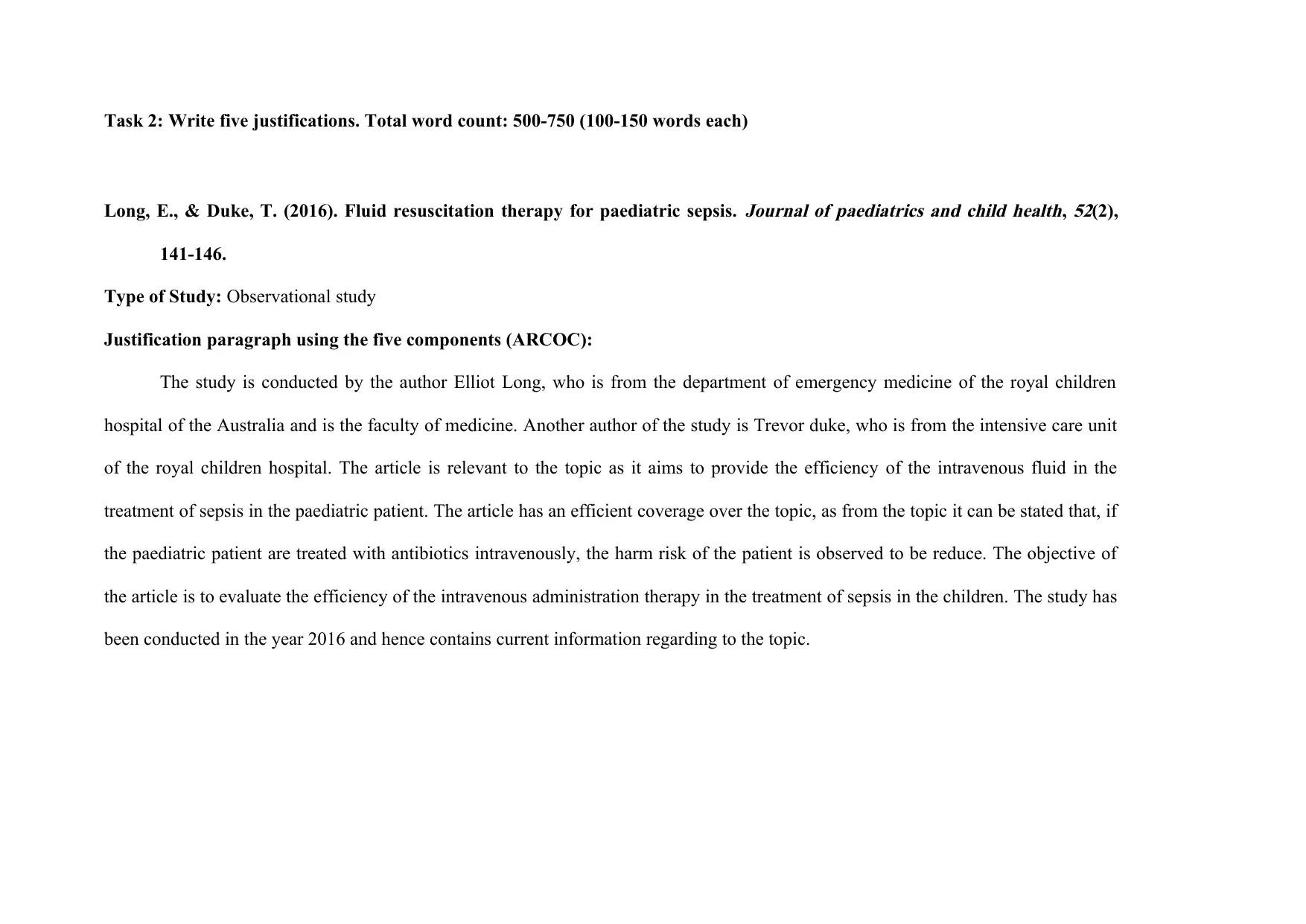
Task 2: Write five justifications. Total word count: 500-750 (100-150 words each)
Long, E., & Duke, T. (2016). Fluid resuscitation therapy for paediatric sepsis.
Journal of paediatrics and child health,
52(2),
141-146.
Type of Study: Observational study
Justification paragraph using the five components (ARCOC):
The study is conducted by the author Elliot Long, who is from the department of emergency medicine of the royal children
hospital of the Australia and is the faculty of medicine. Another author of the study is Trevor duke, who is from the intensive care unit
of the royal children hospital. The article is relevant to the topic as it aims to provide the efficiency of the intravenous fluid in the
treatment of sepsis in the paediatric patient. The article has an efficient coverage over the topic, as from the topic it can be stated that, if
the paediatric patient are treated with antibiotics intravenously, the harm risk of the patient is observed to be reduce. The objective of
the article is to evaluate the efficiency of the intravenous administration therapy in the treatment of sepsis in the children. The study has
been conducted in the year 2016 and hence contains current information regarding to the topic.
Long, E., & Duke, T. (2016). Fluid resuscitation therapy for paediatric sepsis.
Journal of paediatrics and child health,
52(2),
141-146.
Type of Study: Observational study
Justification paragraph using the five components (ARCOC):
The study is conducted by the author Elliot Long, who is from the department of emergency medicine of the royal children
hospital of the Australia and is the faculty of medicine. Another author of the study is Trevor duke, who is from the intensive care unit
of the royal children hospital. The article is relevant to the topic as it aims to provide the efficiency of the intravenous fluid in the
treatment of sepsis in the paediatric patient. The article has an efficient coverage over the topic, as from the topic it can be stated that, if
the paediatric patient are treated with antibiotics intravenously, the harm risk of the patient is observed to be reduce. The objective of
the article is to evaluate the efficiency of the intravenous administration therapy in the treatment of sepsis in the children. The study has
been conducted in the year 2016 and hence contains current information regarding to the topic.
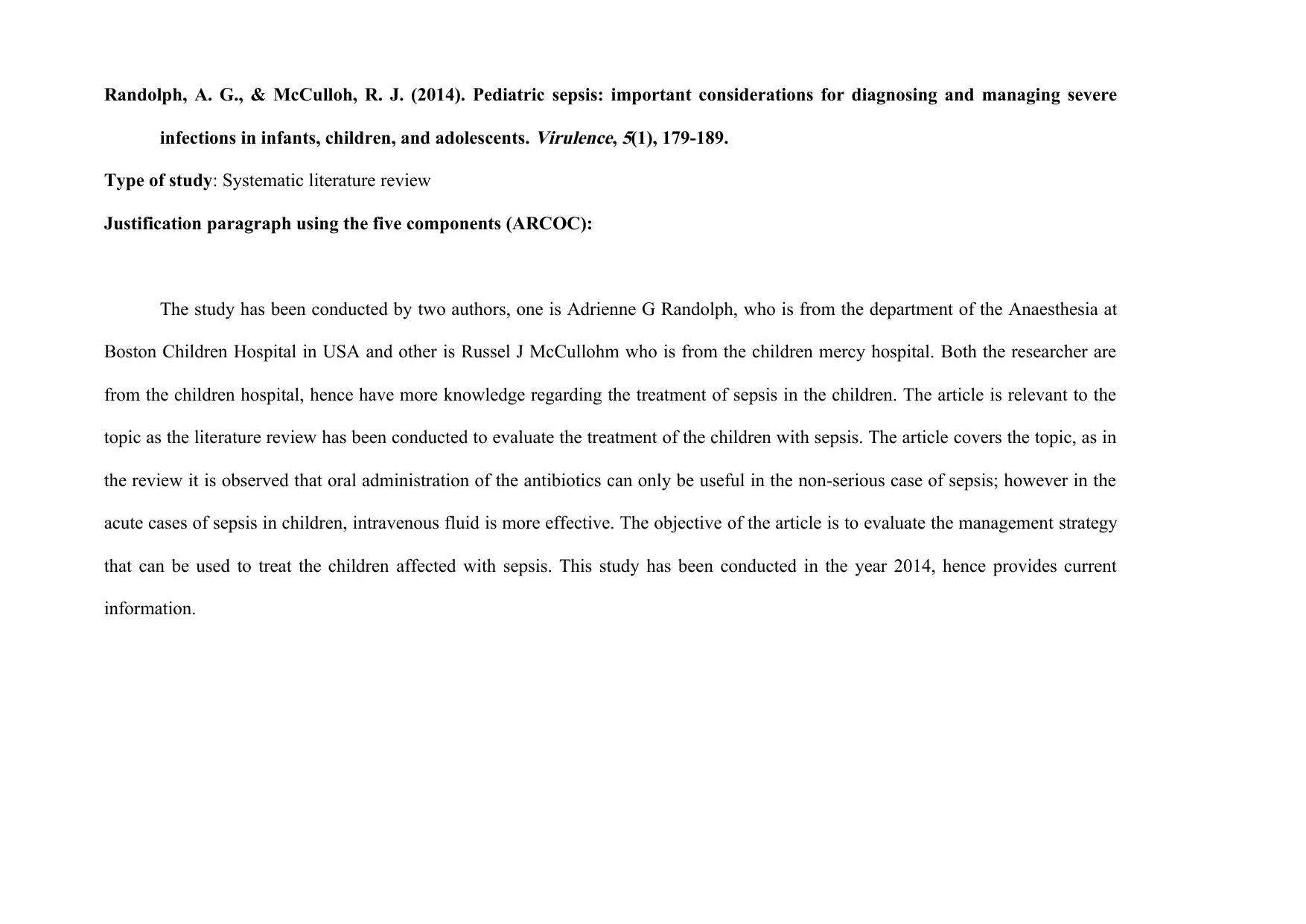
Randolph, A. G., & McCulloh, R. J. (2014). Pediatric sepsis: important considerations for diagnosing and managing severe
infections in infants, children, and adolescents.
Virulence,
5(1), 179-189.
Type of study: Systematic literature review
Justification paragraph using the five components (ARCOC):
The study has been conducted by two authors, one is Adrienne G Randolph, who is from the department of the Anaesthesia at
Boston Children Hospital in USA and other is Russel J McCullohm who is from the children mercy hospital. Both the researcher are
from the children hospital, hence have more knowledge regarding the treatment of sepsis in the children. The article is relevant to the
topic as the literature review has been conducted to evaluate the treatment of the children with sepsis. The article covers the topic, as in
the review it is observed that oral administration of the antibiotics can only be useful in the non-serious case of sepsis; however in the
acute cases of sepsis in children, intravenous fluid is more effective. The objective of the article is to evaluate the management strategy
that can be used to treat the children affected with sepsis. This study has been conducted in the year 2014, hence provides current
information.
infections in infants, children, and adolescents.
Virulence,
5(1), 179-189.
Type of study: Systematic literature review
Justification paragraph using the five components (ARCOC):
The study has been conducted by two authors, one is Adrienne G Randolph, who is from the department of the Anaesthesia at
Boston Children Hospital in USA and other is Russel J McCullohm who is from the children mercy hospital. Both the researcher are
from the children hospital, hence have more knowledge regarding the treatment of sepsis in the children. The article is relevant to the
topic as the literature review has been conducted to evaluate the treatment of the children with sepsis. The article covers the topic, as in
the review it is observed that oral administration of the antibiotics can only be useful in the non-serious case of sepsis; however in the
acute cases of sepsis in children, intravenous fluid is more effective. The objective of the article is to evaluate the management strategy
that can be used to treat the children affected with sepsis. This study has been conducted in the year 2014, hence provides current
information.
⊘ This is a preview!⊘
Do you want full access?
Subscribe today to unlock all pages.

Trusted by 1+ million students worldwide
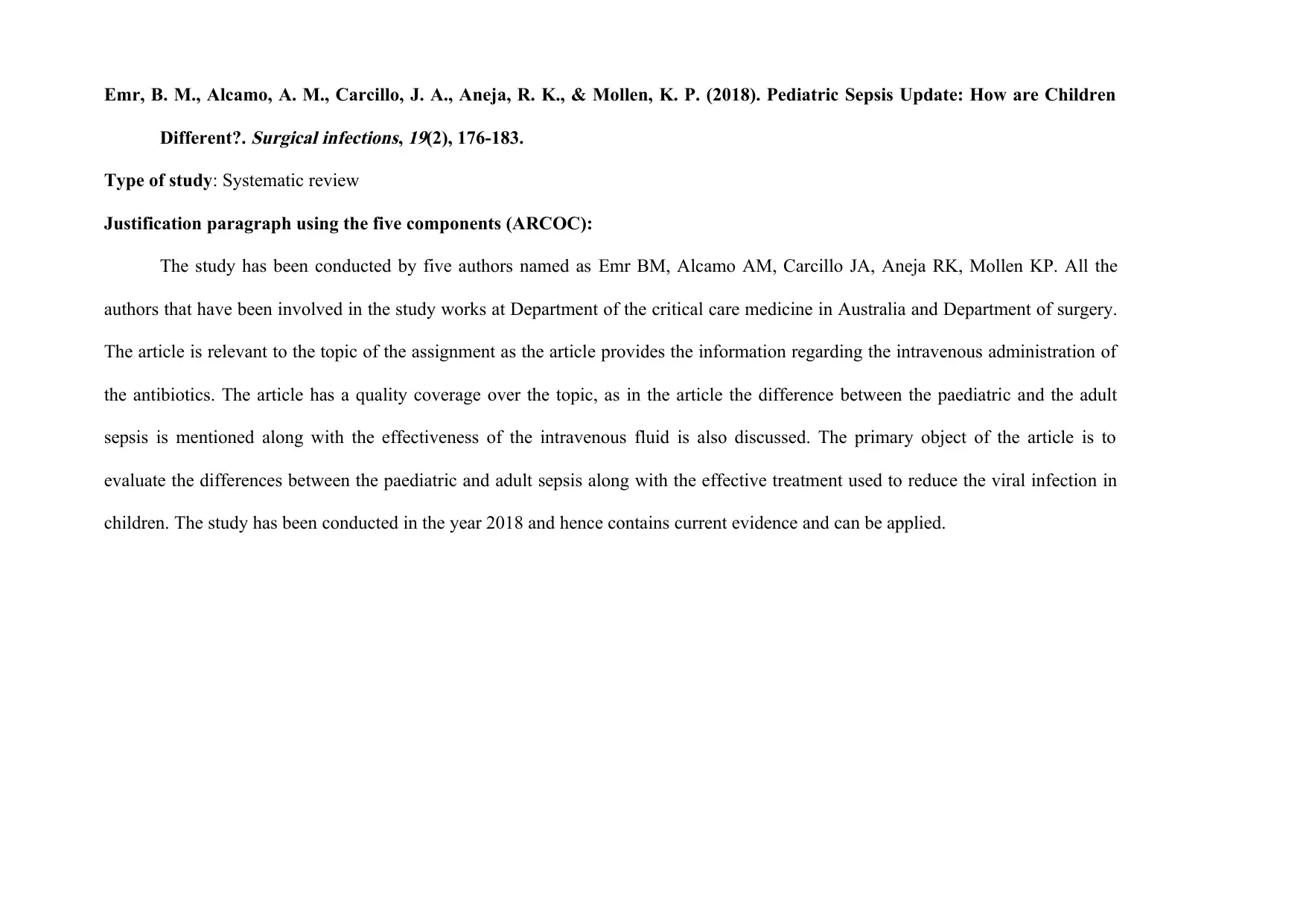
Emr, B. M., Alcamo, A. M., Carcillo, J. A., Aneja, R. K., & Mollen, K. P. (2018). Pediatric Sepsis Update: How are Children
Different?.
Surgical infections,
19(2), 176-183.
Type of study: Systematic review
Justification paragraph using the five components (ARCOC):
The study has been conducted by five authors named as Emr BM, Alcamo AM, Carcillo JA, Aneja RK, Mollen KP. All the
authors that have been involved in the study works at Department of the critical care medicine in Australia and Department of surgery.
The article is relevant to the topic of the assignment as the article provides the information regarding the intravenous administration of
the antibiotics. The article has a quality coverage over the topic, as in the article the difference between the paediatric and the adult
sepsis is mentioned along with the effectiveness of the intravenous fluid is also discussed. The primary object of the article is to
evaluate the differences between the paediatric and adult sepsis along with the effective treatment used to reduce the viral infection in
children. The study has been conducted in the year 2018 and hence contains current evidence and can be applied.
Different?.
Surgical infections,
19(2), 176-183.
Type of study: Systematic review
Justification paragraph using the five components (ARCOC):
The study has been conducted by five authors named as Emr BM, Alcamo AM, Carcillo JA, Aneja RK, Mollen KP. All the
authors that have been involved in the study works at Department of the critical care medicine in Australia and Department of surgery.
The article is relevant to the topic of the assignment as the article provides the information regarding the intravenous administration of
the antibiotics. The article has a quality coverage over the topic, as in the article the difference between the paediatric and the adult
sepsis is mentioned along with the effectiveness of the intravenous fluid is also discussed. The primary object of the article is to
evaluate the differences between the paediatric and adult sepsis along with the effective treatment used to reduce the viral infection in
children. The study has been conducted in the year 2018 and hence contains current evidence and can be applied.
Paraphrase This Document
Need a fresh take? Get an instant paraphrase of this document with our AI Paraphraser
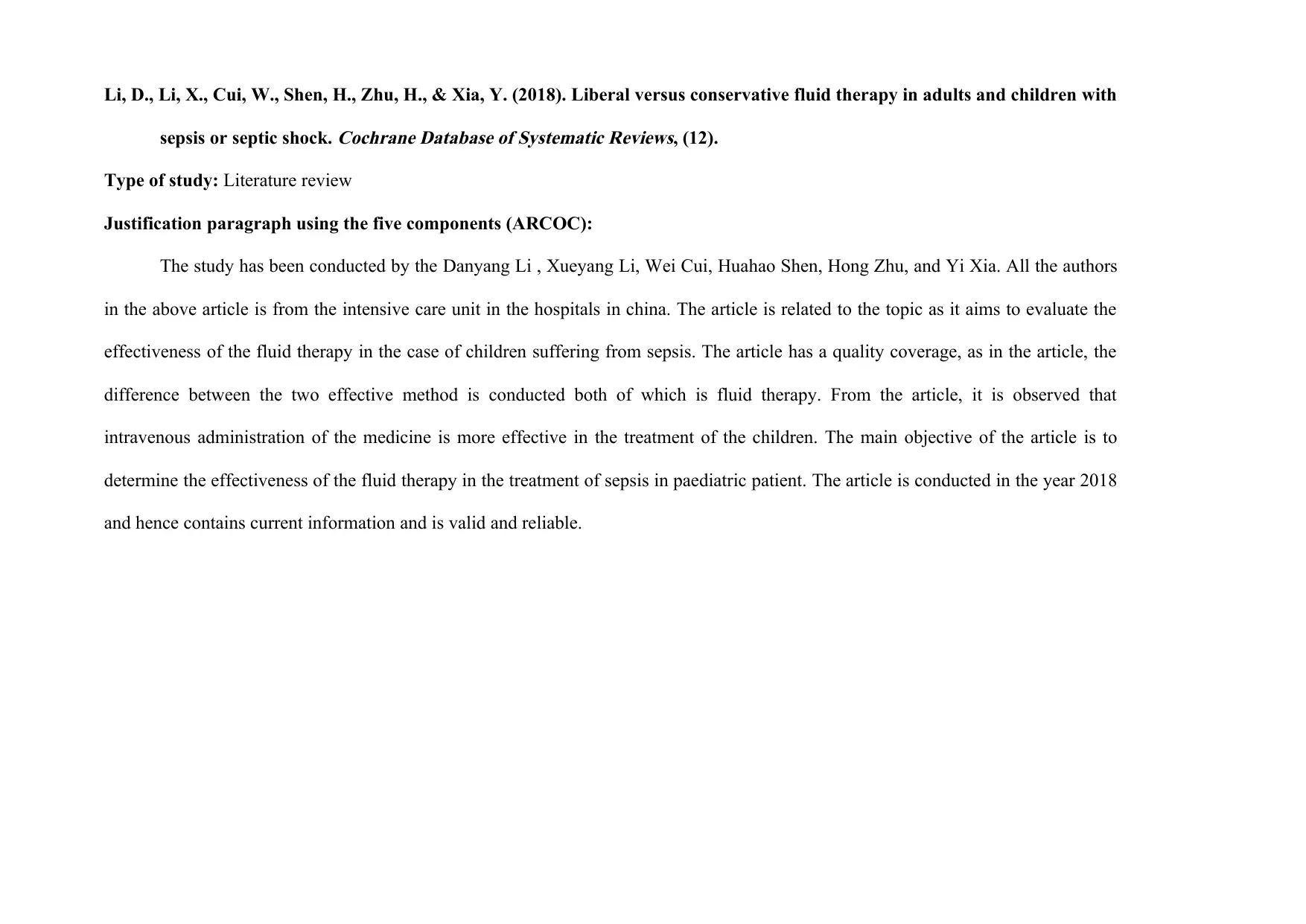
Li, D., Li, X., Cui, W., Shen, H., Zhu, H., & Xia, Y. (2018). Liberal versus conservative fluid therapy in adults and children with
sepsis or septic shock.
Cochrane Database of Systematic Reviews, (12).
Type of study: Literature review
Justification paragraph using the five components (ARCOC):
The study has been conducted by the Danyang Li , Xueyang Li, Wei Cui, Huahao Shen, Hong Zhu, and Yi Xia. All the authors
in the above article is from the intensive care unit in the hospitals in china. The article is related to the topic as it aims to evaluate the
effectiveness of the fluid therapy in the case of children suffering from sepsis. The article has a quality coverage, as in the article, the
difference between the two effective method is conducted both of which is fluid therapy. From the article, it is observed that
intravenous administration of the medicine is more effective in the treatment of the children. The main objective of the article is to
determine the effectiveness of the fluid therapy in the treatment of sepsis in paediatric patient. The article is conducted in the year 2018
and hence contains current information and is valid and reliable.
sepsis or septic shock.
Cochrane Database of Systematic Reviews, (12).
Type of study: Literature review
Justification paragraph using the five components (ARCOC):
The study has been conducted by the Danyang Li , Xueyang Li, Wei Cui, Huahao Shen, Hong Zhu, and Yi Xia. All the authors
in the above article is from the intensive care unit in the hospitals in china. The article is related to the topic as it aims to evaluate the
effectiveness of the fluid therapy in the case of children suffering from sepsis. The article has a quality coverage, as in the article, the
difference between the two effective method is conducted both of which is fluid therapy. From the article, it is observed that
intravenous administration of the medicine is more effective in the treatment of the children. The main objective of the article is to
determine the effectiveness of the fluid therapy in the treatment of sepsis in paediatric patient. The article is conducted in the year 2018
and hence contains current information and is valid and reliable.
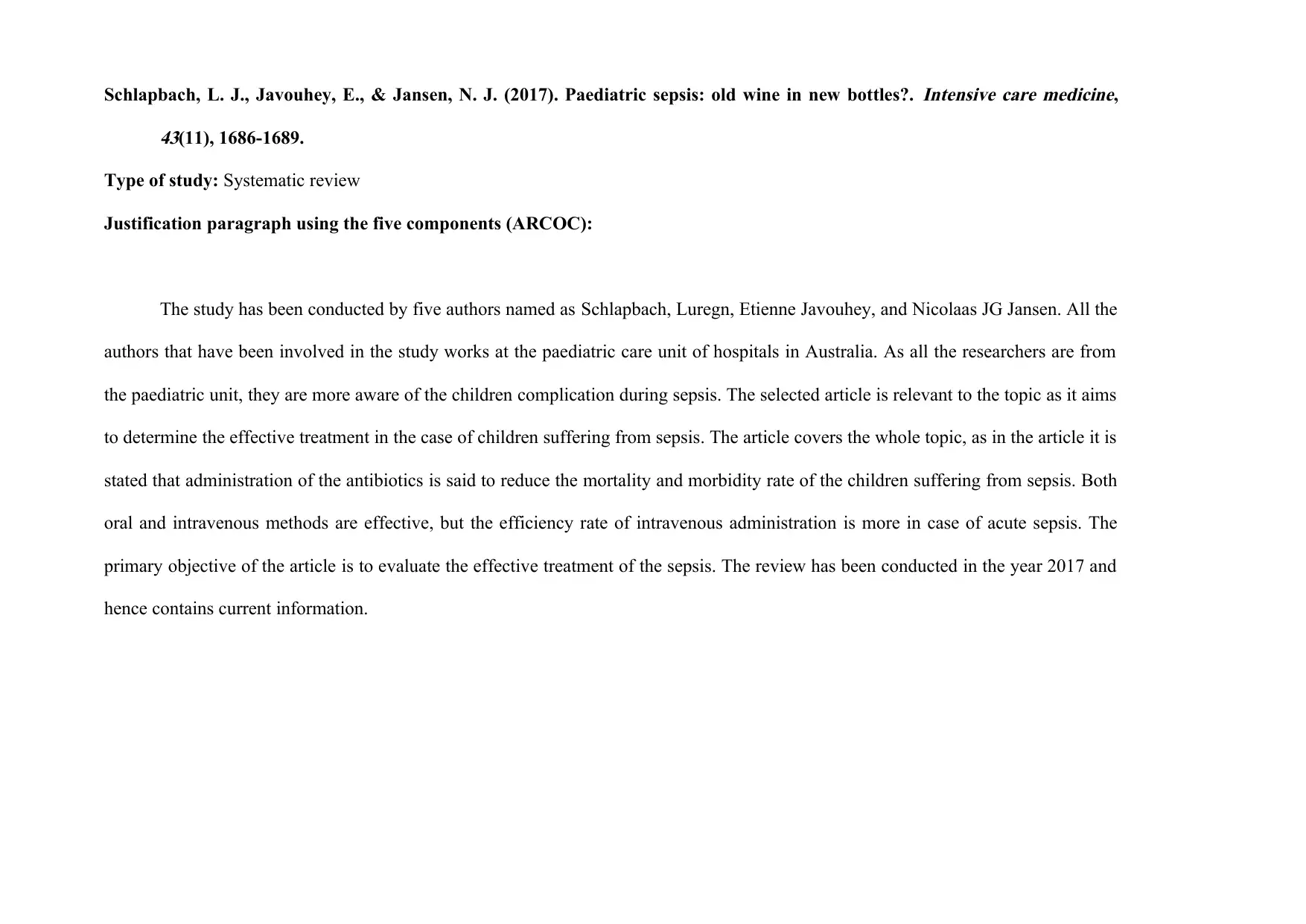
Schlapbach, L. J., Javouhey, E., & Jansen, N. J. (2017). Paediatric sepsis: old wine in new bottles?.
Intensive care medicine,43(11), 1686-1689.
Type of study: Systematic review
Justification paragraph using the five components (ARCOC):
The study has been conducted by five authors named as Schlapbach, Luregn, Etienne Javouhey, and Nicolaas JG Jansen. All the
authors that have been involved in the study works at the paediatric care unit of hospitals in Australia. As all the researchers are from
the paediatric unit, they are more aware of the children complication during sepsis. The selected article is relevant to the topic as it aims
to determine the effective treatment in the case of children suffering from sepsis. The article covers the whole topic, as in the article it is
stated that administration of the antibiotics is said to reduce the mortality and morbidity rate of the children suffering from sepsis. Both
oral and intravenous methods are effective, but the efficiency rate of intravenous administration is more in case of acute sepsis. The
primary objective of the article is to evaluate the effective treatment of the sepsis. The review has been conducted in the year 2017 and
hence contains current information.
Intensive care medicine,43(11), 1686-1689.
Type of study: Systematic review
Justification paragraph using the five components (ARCOC):
The study has been conducted by five authors named as Schlapbach, Luregn, Etienne Javouhey, and Nicolaas JG Jansen. All the
authors that have been involved in the study works at the paediatric care unit of hospitals in Australia. As all the researchers are from
the paediatric unit, they are more aware of the children complication during sepsis. The selected article is relevant to the topic as it aims
to determine the effective treatment in the case of children suffering from sepsis. The article covers the whole topic, as in the article it is
stated that administration of the antibiotics is said to reduce the mortality and morbidity rate of the children suffering from sepsis. Both
oral and intravenous methods are effective, but the efficiency rate of intravenous administration is more in case of acute sepsis. The
primary objective of the article is to evaluate the effective treatment of the sepsis. The review has been conducted in the year 2017 and
hence contains current information.
⊘ This is a preview!⊘
Do you want full access?
Subscribe today to unlock all pages.

Trusted by 1+ million students worldwide
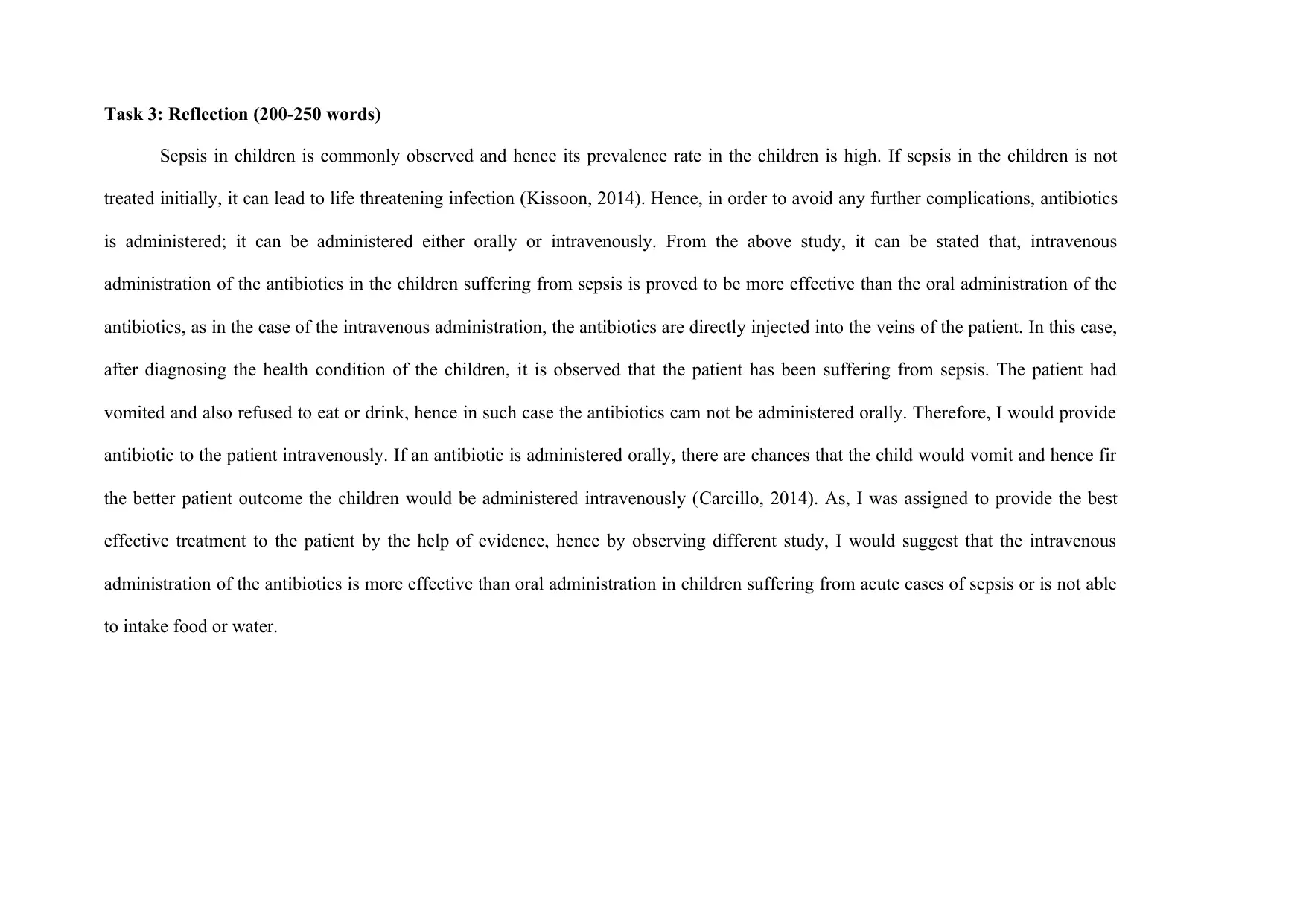
Task 3: Reflection (200-250 words)
Sepsis in children is commonly observed and hence its prevalence rate in the children is high. If sepsis in the children is not
treated initially, it can lead to life threatening infection (Kissoon, 2014). Hence, in order to avoid any further complications, antibiotics
is administered; it can be administered either orally or intravenously. From the above study, it can be stated that, intravenous
administration of the antibiotics in the children suffering from sepsis is proved to be more effective than the oral administration of the
antibiotics, as in the case of the intravenous administration, the antibiotics are directly injected into the veins of the patient. In this case,
after diagnosing the health condition of the children, it is observed that the patient has been suffering from sepsis. The patient had
vomited and also refused to eat or drink, hence in such case the antibiotics cam not be administered orally. Therefore, I would provide
antibiotic to the patient intravenously. If an antibiotic is administered orally, there are chances that the child would vomit and hence fir
the better patient outcome the children would be administered intravenously (Carcillo, 2014). As, I was assigned to provide the best
effective treatment to the patient by the help of evidence, hence by observing different study, I would suggest that the intravenous
administration of the antibiotics is more effective than oral administration in children suffering from acute cases of sepsis or is not able
to intake food or water.
Sepsis in children is commonly observed and hence its prevalence rate in the children is high. If sepsis in the children is not
treated initially, it can lead to life threatening infection (Kissoon, 2014). Hence, in order to avoid any further complications, antibiotics
is administered; it can be administered either orally or intravenously. From the above study, it can be stated that, intravenous
administration of the antibiotics in the children suffering from sepsis is proved to be more effective than the oral administration of the
antibiotics, as in the case of the intravenous administration, the antibiotics are directly injected into the veins of the patient. In this case,
after diagnosing the health condition of the children, it is observed that the patient has been suffering from sepsis. The patient had
vomited and also refused to eat or drink, hence in such case the antibiotics cam not be administered orally. Therefore, I would provide
antibiotic to the patient intravenously. If an antibiotic is administered orally, there are chances that the child would vomit and hence fir
the better patient outcome the children would be administered intravenously (Carcillo, 2014). As, I was assigned to provide the best
effective treatment to the patient by the help of evidence, hence by observing different study, I would suggest that the intravenous
administration of the antibiotics is more effective than oral administration in children suffering from acute cases of sepsis or is not able
to intake food or water.
Paraphrase This Document
Need a fresh take? Get an instant paraphrase of this document with our AI Paraphraser
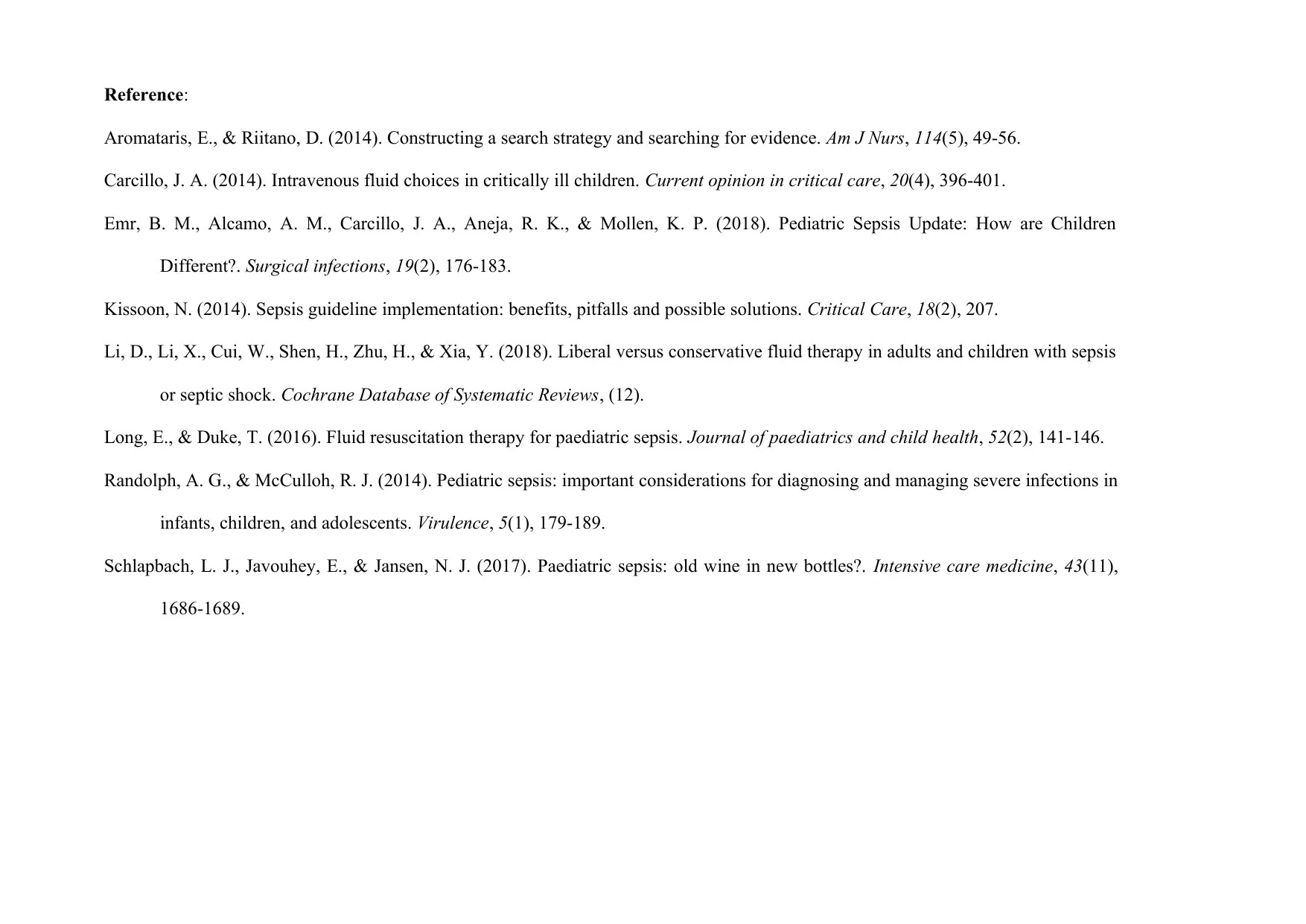
Reference:
Aromataris, E., & Riitano, D. (2014). Constructing a search strategy and searching for evidence. Am J Nurs, 114(5), 49-56.
Carcillo, J. A. (2014). Intravenous fluid choices in critically ill children. Current opinion in critical care, 20(4), 396-401.
Emr, B. M., Alcamo, A. M., Carcillo, J. A., Aneja, R. K., & Mollen, K. P. (2018). Pediatric Sepsis Update: How are Children
Different?. Surgical infections, 19(2), 176-183.
Kissoon, N. (2014). Sepsis guideline implementation: benefits, pitfalls and possible solutions. Critical Care, 18(2), 207.
Li, D., Li, X., Cui, W., Shen, H., Zhu, H., & Xia, Y. (2018). Liberal versus conservative fluid therapy in adults and children with sepsis
or septic shock. Cochrane Database of Systematic Reviews, (12).
Long, E., & Duke, T. (2016). Fluid resuscitation therapy for paediatric sepsis. Journal of paediatrics and child health, 52(2), 141-146.
Randolph, A. G., & McCulloh, R. J. (2014). Pediatric sepsis: important considerations for diagnosing and managing severe infections in
infants, children, and adolescents. Virulence, 5(1), 179-189.
Schlapbach, L. J., Javouhey, E., & Jansen, N. J. (2017). Paediatric sepsis: old wine in new bottles?. Intensive care medicine, 43(11),
1686-1689.
Aromataris, E., & Riitano, D. (2014). Constructing a search strategy and searching for evidence. Am J Nurs, 114(5), 49-56.
Carcillo, J. A. (2014). Intravenous fluid choices in critically ill children. Current opinion in critical care, 20(4), 396-401.
Emr, B. M., Alcamo, A. M., Carcillo, J. A., Aneja, R. K., & Mollen, K. P. (2018). Pediatric Sepsis Update: How are Children
Different?. Surgical infections, 19(2), 176-183.
Kissoon, N. (2014). Sepsis guideline implementation: benefits, pitfalls and possible solutions. Critical Care, 18(2), 207.
Li, D., Li, X., Cui, W., Shen, H., Zhu, H., & Xia, Y. (2018). Liberal versus conservative fluid therapy in adults and children with sepsis
or septic shock. Cochrane Database of Systematic Reviews, (12).
Long, E., & Duke, T. (2016). Fluid resuscitation therapy for paediatric sepsis. Journal of paediatrics and child health, 52(2), 141-146.
Randolph, A. G., & McCulloh, R. J. (2014). Pediatric sepsis: important considerations for diagnosing and managing severe infections in
infants, children, and adolescents. Virulence, 5(1), 179-189.
Schlapbach, L. J., Javouhey, E., & Jansen, N. J. (2017). Paediatric sepsis: old wine in new bottles?. Intensive care medicine, 43(11),
1686-1689.
1 out of 8
Related Documents
Your All-in-One AI-Powered Toolkit for Academic Success.
+13062052269
info@desklib.com
Available 24*7 on WhatsApp / Email
![[object Object]](/_next/static/media/star-bottom.7253800d.svg)
Unlock your academic potential
Copyright © 2020–2025 A2Z Services. All Rights Reserved. Developed and managed by ZUCOL.



